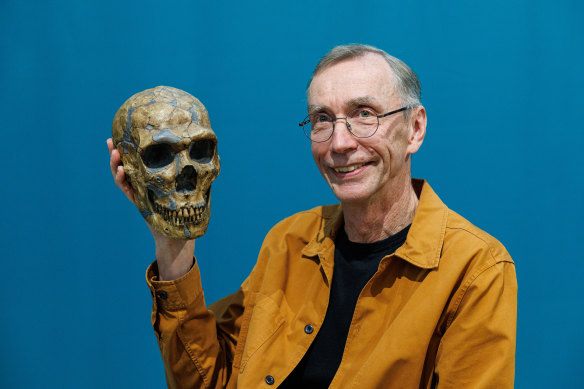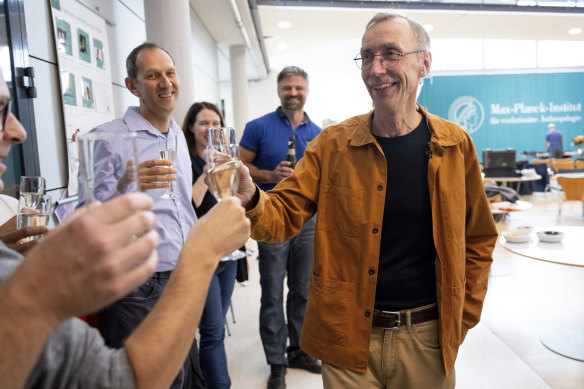Leipzig, Germany: Swedish scientist Svante Paabo has won the Nobel Prize in medicine for discoveries in human evolution that unlocked secrets of Neanderthal DNA that helped us understand what makes humans unique and provided key insights into our immune system, including our vulnerability to severe COVID-19.
Techniques that Paabo spearheaded allowed researchers to compare the genome of modern humans and that of other hominins — the Denisovans as well as Neanderthals.
Svante Paabo, director of the Max Planck Institute for Evolutionary Anthropology, with a model of a Neanderthal skeleton.Credit:Getty
“Just as you do an archeological excavation to find out about the past, we sort of make excavations in the human genome,” he said at a news conference held by Max Planck Institute for Evolutionary Anthropology in Leipzig.
While Neanderthal bones were first discovered in the mid-19th century, only by understanding their DNA — often referred to as the code of life — have scientists been able to fully understand the links between species.
This included the time when modern humans and Neanderthals diverged as a species, around 800,000 years ago.
“Paabo and his team also surprisingly found that gene flow had occurred from Neanderthals to Homo sapiens, demonstrating that they had children together during periods of co-existence,” said Anna Wedell, chair of the Nobel Committee.
This transfer of genes between hominin species affects how the immune system of modern humans reacts to infections, such as the coronavirus. People outside Africa have 1 to 2 per cent of Neanderthal genes. Neanderthals were never in Africa, so there’s no known direct contribution to people in sub-Saharan Africa.
Paabo and his team managed to extract DNA from a tiny finger bone found in a cave in Siberia, leading to the recognition of a new species of ancient humans they called Denisovans.
Wedell called it “a sensational discovery” that showed Neanderthals and Denisovans were sister groups that split from each other around 600,000 years ago. Denisovan genes have been found in up to 6 per ccent of modern humans in Asia and Southeast Asia, indicating interbreeding occurred there too.
“By mixing with them after migrating out of Africa, Homo sapiens picked up sequences that improved their chances to survive in their new environments,” Wedell said. For example, Tibetans share a gene with Denisovans that helps them adapt to high altitude.
Svante Paabo toasts with champagne with his colleagues at the Max Planck Institute for Evolutionary Anthropology in Leipzig.Credit:AP
Paabo said he was surprised to learn of his win, and at first thought it was an elaborate prank by colleagues or a call about his summer home.
“So I was just gulping down the last cup of tea to go and pick up my daughter at her nanny where she has had an overnight stay, and then I got this call from Sweden,” he said in an interview on the Nobel Prizes homepage. “I, of course, thought it had something to do with our little summer house in Sweden. I thought, ‘Oh the lawn mower’s broken down or something.’”
He also mused about what would have happened if Neanderthals had survived another 40,000 years.
“Would we see even worse racism against Neanderthals because they were really in some sense different from us? Or would we actually see our place in the living world quite in a different way when we would have other forms of humans there that are very like us but still different,” he said.
Paabo, 67, performed his prizewinning studies at the University of Munich and at the Max Planck Institute.
Scientists in the field lauded the Nobel Committee’s choice.
David Reich, a geneticist at Harvard Medical School, said he was thrilled, fearing the field of ancient DNA might “fall between the cracks”.
By recognising that DNA can be preserved for tens of thousands of years — and developing ways to extract it — Paabo and his team created a completely new way to answer questions about our past, Reich said.
“It’s totally reconfigured our understanding of human variation and human history,” said Reich, who is paid by the Howard Hughes Medical Institute.
Dr Eric Green, director of the National Human Genome Research Institute at the US National Institutes of Health, called it “a great day for genomics,” a relatively young field first named in 1987.
The Human Genome project, which ran from 1990-2003, “got us the first sequence of the human genome, and we’ve improved that sequence ever since,” Green said.
When you sequence DNA from an ancient fossil, you only have “vanishingly small amounts,” Green said. Among Paabo’s innovations was figuring out methods for extracting and preserving these tiny amounts. He was then able to lay pieces of the Neanderthal genome sequence against the human sequencing of the Human Genome Project.
AP
Get a note directly from our foreign correspondents on what’s making headlines around the world. Sign up for the weekly What in the World newsletter here.
Most Viewed in World
From our partners
Source: Read Full Article


